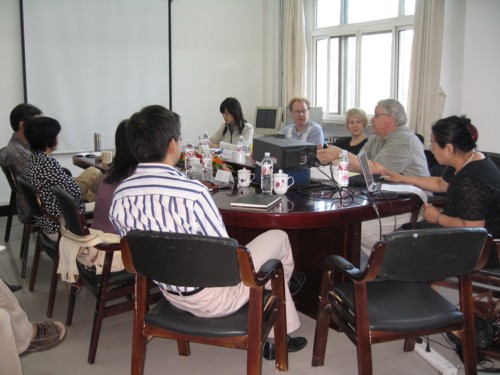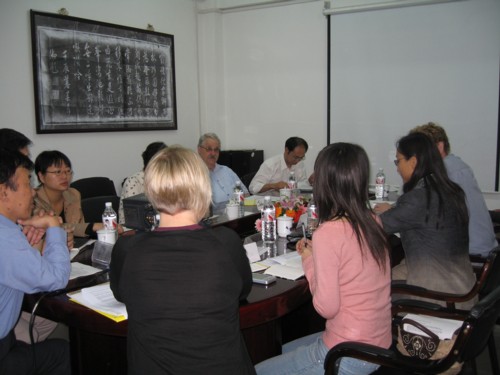|


几位来自美国明尼苏达大学的学者近日将在我所进行学术访问,并联合召开“中国18-19世纪的
营养与生计”专题研讨会。会议邀请了美国和中国从事人类学、生态系统学、流行病学、人口统计
学和历史学等各方面的学者参加,组成了一个国际的跨学科的研究小组,对相关问题进行了为期三
天的详细研讨。
参加会议人员名单:
Chris Lsett 明尼苏达大学 (History Department)
John Himes 明尼苏达大学 (Epidemiology)
Cathy Fitch 明尼苏达大学 (Minnesota Population Center)
成崇德 中国人民大学清史研究所
黄兴涛 中国人民大学清史研究所
杨念群 中国人民大学清史研究所
张 研 中国人民大学清史研究所
高王凌 中国人民大学清史研究所
蒋 妍 中国人民大学统计学院
朱淑元 中国第一历史档案馆
余新忠 南开大学历史学院
以下为9月18-20日学术交流活动安排:
Beijing Meeting Agenda, September 18, 19, 20
Tuesday, September 18 (9 am to noon)
1. General Introductions of participants: names, expertise, affiliations and
description of project. Translation of proposal to be handed out before meeting.
Overview of project: Research questions; research goals (articles, books, database
distribution); present state (funding applications); proposed division of labor (data
collection and checking in Beijing with MPC assistance; analysis in MPC in collaboration
with Chinese colleagues); products (collaborative volumes and articles). Introduction
of the MPC by Cathy Fitch: what is the MPC (interdisciplinary center for demographic
research), past, current and future MPC projects (US census; international censuses;
international health surveys), what can MPC do for us (conceptual work; data
distribution)
2a. Research questions and data gathering
We have specified research questions for their impact on the field and feasibility.
Some of the data necessary to answer these questions are contained within the source
data; others must be attained elsewhere. i The effect of labor/land ratio: Where is
this data to be gotten (what are the best secondary sources? Do we give credence to
local studies over national studies? Which regional studies are best?); What are the
smallest administrative units for which the data are available? We believe that
prefectures will be most useful for statistical analysis. What years can be reasonably
achieved across the eighteenth and first half of the nineteenth centuries for sampling (given the limitation of population and arable land data what can be best expected)? We need as many years as possible, but 4
-6 years over the time period would be sufficient.
The effect of occupation and socio-economic status: Individual data are to be garnered from the original source. We
estimate that a large proportion of individuals in our database will have some or
all information needed to make a determination of social status, and we suggest using
the HISCO classification scheme to create a set of work categories specific to Qing
China: see: http://www.nappdata.org/napp-action/variableDescription.do?
mnemonic=OCC. We will also want to order occupations by socioeconomic status; a rank
ordering of 3-5 broad classifications would be useful.
We also need to determine representativeness of our sample with respect to occupation.
What are the best sources describing the occupational distribution during the time
period we will be studying? What about measures of regional wealth? How can we
feasible create macro measurements of per capita income by region? Wage data? Farm
income?
iii The effect of gender: Individual data are to be garnered from the original source.
What problems if any arise from our lower sampling of women? Most of our data for women
will come from victims of sex crimes. What are the possible biases? We suggest
comparing women who are victims of sex crimes against women who were victims of non-
sex crimes to check for biases.
iv. The effect of place: We propose collecting information about local regions. We
will attach these characteristics to the individual data to test some of our hypotheses
about commercialization and crop yields. The following data are
v.1 commercialization: How will we measure commercialization? We propose counting
changes in number of market towns listed in local gazetteers for sampled regions. We
will chose regions that represent a cross section of commercial forces from less to
more commercialized (ie. Jiangnan, Huabei, Huguang)? Can we think of any other
sources or methods to measure the place effect of com,mercialization? And, can we
get this information for multiple points in time?
v.2 yield/famine. Where can these data be gotten? How do we aggregate yields for
place/region? How do we ensure a standardization of yield data quality? Where
does famine data come from? Can we use the Qingshi suo famine project data? What
technical problems are associated with this data and how can they be remedied? How
accessible is it? Is it standardized? Can it be standardized?
v.3 other possible place effects: What other attributes of place should we take
into account and how would we measure them? For example the effects of disease—
what kind of data are there and how can it be used? We want to be able to test for
factors that might simultaneously affect the outcome (height) and predictor
(commercialization and/or crop yields). Useful information for this purpose might
include climate (rainfall, temperatures), elevation, proximity to water, and
distance from major cities. Other possibilities?
Wednesday, September 19 (9-noon)
2b Work responsibilities and issues
i. Sources of funding in US, Taiwan, and China? Three possible sampling methods
depending on budget: 10,000 individuals over three years, 60,000 over three years
and 200,000 over five years. MPC will apply to NIH, NSF and CCK. How about China
side? Is there money in China we can apply for? Information/agreements to be
supplied to applicant?
ii. Division of labor: MPC and RENDA collaborate on data collection and data
consistency software. RENDA gathers all data, checks all data consistency with
MPC assistance; MPC develops and distributes databases; MPC performs analysis in
cooperation with Chinese scholars. All publications are collaborative unless
otherwise agreed to.
iii. Research budget:
a. Researchers: China costs: hours worked per week and per year; hourly pay rate;
number of RAs employed at anyone time to gather data; training: other issues?
b. Facilities and equipments: space, computers, anything else needed at Renda?
c. Travel and meetings: MPC and RENDA host meetings alternately every 6 months in
first three years; individual travel to Beijing to assist in oversight and data
checking. Anything else?
d. Archive assistance: can we hire an archivist? Cost? Availability to our
researchers?
Thursday, September 20
Visit the First National Archives: Meet with archivist Zhu Shuyuan, exam first hand
cases in both micro-film and original state.
Issues to consider: possible sampling strategies (based on how data are stored) and
would it be possible to make copies of cases using cameras.
项目说明
我们的项目旨在通过关系种群动态,经济和生活水平来测试跨学科最基本的理论。尤其是,我
们将测试新古典经济学和马尔萨斯的预言中,有关的人类行为和经济成果的各自论点是否正确的。
这些关于人类行为的模型对社会科学产生了持久影响,尤其是我们对市场发展和人口增长对生活水
准的影响的理解。在一般史学,古典经济学认为,市场的扩大和人口的增长加上劳动分工的出现和
没有体制障碍,导致劳动生产率的增长和生活水平的提高。马尔萨斯的论点则相反,他认为人口增
长往往超出经济产出,并导致生活水准的下降。
要想检验这些理论,我们将利用一个独特的来源建立第一个二十世纪之前的中国全国性的纵向
身高指数。这项创新的数据库将是历史最长的连续的体位指数数据库;它将包括从1680年到1911年的
四十万人。我们将利用这些数据来测试以下数据的趋势:身高中间值,控制其他变量所包含的数
据,诸如社会经济地位,性别,年龄,地理等。该数据库最终将被公开提供给研究人员,使他们可
以衡量历史上的儿童营养和生活水平。它还将向研究者提供最大的生活水平的历史数据库,使他们
可以验证一些最基础的社会科学理论,及环境对营养和儿童成长的影响方面的预测。
本项目有数据收集和研究两部分工作
1、我们将利用超过一百万个谋杀受害者的纪录,为中国近代人口制定首个有全国代表性的人体
测量数据库。该项目的第一阶段,我们将记录人体测量,重要统计,居住地,出生地,以及社会经
济背景,对象是出生在1680至1800年间的大约二十万成人 。
2、我们将利用数据处理两个研究问题。第一,在18世纪中国,从身体变化上看,生活水平的主
要趋势是什么?我们会控制环境和社会变量,来确定关键性的影响,以分析体位趋势。其次,借鉴
其他来源,我们会询问,是否工作的增加和食品商品化导致初期下降生物福祉。因为在欧洲和北
美,历史情况已被证明如此。
为搜集和研究这个数据,我们已经形成了一个国际和跨学科小组,其中包括美国和中国从事人
类学,生态系统学,流行病学,统计方法,人口统计学和历史各方面的学者。国际方案办公室
( OPI )的资金将为在北京和明尼阿波历斯的会议提供经费,在会议期间,我们将制定一个研究计
划和长期资金方案,以支持该项目的进行。
目前该研究领域的状态
最近对中国的人口与社会史的新研究成果,引发了一场关于东亚和欧洲经济增长的根源的争
论。两个最近出版的,由李中清、王锋( 1999 )和彭慕兰( 2000 )完成的作品,寻求推翻中国
社会和人口史的根本理论,并以此挑战我们对欧洲和东亚社会的许多历史认识。传统观点认为中国
和东亚家庭倾向于以出生地为中心;而且,东亚人口高生育率和高死亡率并存,导致生活水平得不
到改善。但是上述新派学者否定了这些观点。他们利用中文数据,提出另一套理论:生育率得到控
制,死亡率在一般水平,市场扩大,经济增长,人民生活水平得到提高,等等,基本相似于欧洲的
历史情况。一些欧洲和中国的社会和经济史学界的著名学者对他们的阐释持否定态度(黄2002
年; 布瑞那和艾人民2002年;艾伦2005年;沃尔夫2001 ) 。但是,由于缺乏健全的纵向国内生产总
值和工资数据,并采取其他衡量生活水平的手段,这场辩论无法进行有意义的比较。
这个项目是有创意的,因为它使用的体位措施,以重建中国经济的发展水平和人口的健康和生
活水平,以更好的比较东亚和欧洲历史上的经济表现。学者们已经认识到相同环境条件的人群,成
年身高与儿童营养和健康密切相关,进而与经济表现密切相关( 伍记思卓科1998年;丹拿1986,
1994年; 斯代寇1995卷;科姆洛什1989 )。有人认为,作为经济数据,营养和身高的改变胜于其它
关于工资的长期经济数据。后者不 “考虑外在环境因素的影响,周期性波动,家庭内部的资源分
配,或不平等的社会层面” (科姆洛什和贝谈 2004 ) 。
现有前现代东亚的体位指数时间范围太窄,无法用来进行实用比较。这些数据都来自沿海大城
市市区男性人口(例如,摩根 2004年; 欧资2003年),并完全限于十九世纪的最后二十年和二十世
纪。这类人口只占东亚地区人口历史结构的一小部分,相比之下,人口中的大部分为穷人和农业人
口。我们的数据没有这些弱点,允许与现有的欧洲和美国的数据进行有意义的比较。
因为我们提出的数据源广泛包含了前现代中国社会的人口,包括大量的观察数据,并涵盖了很
长的时间,并包括清代所有的1300个县。我们相信它比现有的人体数据库会更具有代表性。这一数
据库将提供研究者时间最长、测量最系统的成人身高数据。我们准备创建的纵向数据库,不仅能提
供新的数据,而且将开辟新的研究道路,将影响到我们如何理解较长时间的人类生活状况。它将使
研究的重心从独家侧重欧洲人口到世界各地。更具体地说,它将使研究人员第一次理解童年的身体
成长的决定因素,并将亚洲最大的人口与欧洲和美洲人口进行比较。
数据来源和数据构建
在中国北京第一历史档案馆,从1736年到1911年的100多万的凶杀记录里载有身高和其他生物测
量。每个凶杀纪录(包括误杀)包括对受害人尸体的描述。一半以上的记录包括受害者的身高。作
为第一步,我们主要选择1736和1830年之间的案例,因为这样做效率是最高的。清朝初年的凶杀纪
录可以用来填补理解上的空白。1736-1830也是近年来引起最多争议的时期。
包括在这些凶杀纪录中的精确的人体测量数据,加上人口和经济信息,是理想的研究和预测健
康和营养状况的资料。每个凶杀记录提供的死亡日期,日期尸检,验尸人名字,受害人的性别,年
龄,居住地,出生地。记录在法律案件的证人供词对受害人的职业,社会地位,兄弟姐妹出生顺
序,婚姻状况,子女数量和性别(如果有的话)提供补充资料 。
我们载于这些凶杀纪录的高质量信息有充分的信心,以及全国各地的记录在一段时间内的一致
性。其他学者已建立凶杀记录在历史研究中的的一般可靠性(马考理 1998;索默2000年; 布欧
依 2001年;艾人民2007)。因为在清代,谋杀案的法律准则没有变化,因为法院必须向中央政府报
告所有谋杀和对谋杀案的审判,所以包括在这些记录中的案件类型保持不变(第西1970年; 布欧依
2001 )。此外,在整个清代,在全国各地,无论是尸体检验和测量,还是审理过程,以及对案件的
判决,都是基本一致的。
|

